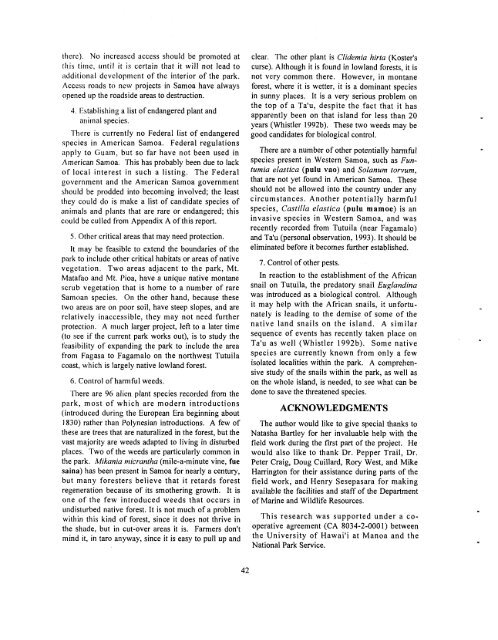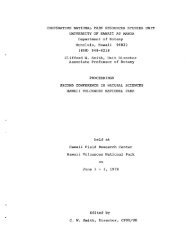american samoa - University of Hawaii at Manoa
american samoa - University of Hawaii at Manoa
american samoa - University of Hawaii at Manoa
You also want an ePaper? Increase the reach of your titles
YUMPU automatically turns print PDFs into web optimized ePapers that Google loves.
there). No increased access should be promoted <strong>at</strong><br />
this time, until it is certain th<strong>at</strong> it will not lead to<br />
additional development <strong>of</strong> the interior <strong>of</strong> the park.<br />
Access roads to new projects in Samoa have always<br />
opened up the roadside areas to destruction.<br />
4. Establishing a list <strong>of</strong> endangered plant and<br />
animal species.<br />
There is currently no Federal list <strong>of</strong> endangered<br />
species in American Samoa. Federal regul<strong>at</strong>ions<br />
apply to Guam, but so far have not been used in<br />
American Samoa. This has probably been due to lack<br />
<strong>of</strong> local interest in such a listing. The Federal<br />
government and the American Samoa government<br />
should be prodded into becoming involved; the least<br />
they could do is make a list <strong>of</strong> candid<strong>at</strong>e species <strong>of</strong><br />
animals and plants th<strong>at</strong> are rare or endangered; this<br />
could be culled from Appendix A <strong>of</strong> this report.<br />
5. Other critical areas th<strong>at</strong> may need protection.<br />
It may be feasible to extend the boundaries <strong>of</strong> the<br />
park to include other critical habit<strong>at</strong>s or areas <strong>of</strong> n<strong>at</strong>ive<br />
veget<strong>at</strong>ion. Two areas adjacent to the park, Mt.<br />
M<strong>at</strong>afao and Mt. Pioa, have a unique n<strong>at</strong>ive montane<br />
scrub veget<strong>at</strong>ion th<strong>at</strong> is home to a number <strong>of</strong> rare<br />
Samoan species. On the other hand, because these<br />
two areas are on poor soil, have steep slopes, and are<br />
rel<strong>at</strong>ively inaccessible, they may not need further<br />
protection. A much larger project, left to a l<strong>at</strong>er time<br />
(to see if the current park works out), is to study the<br />
feasibility <strong>of</strong> expanding the park to include the area<br />
from Fagasa to Fagamalo on the northwest Tutuila<br />
coast, which is largely n<strong>at</strong>ive lowland forest.<br />
6. Control <strong>of</strong> harmful weeds.<br />
There are 96 alien plant species recorded from the<br />
park, most <strong>of</strong> which are modern introductions<br />
(introduced during the European Era beginning about<br />
1830) r<strong>at</strong>her than Polynesian introductions. A few <strong>of</strong><br />
these are trees th<strong>at</strong> are n<strong>at</strong>uralized in the forest, but the<br />
vast majority are weeds adapted to living in disturbed<br />
places. Two <strong>of</strong> the weeds are particularly common in<br />
the park. Mikania micrantha (mile-a-minute vine, fue<br />
saina) has been present in Samoa for nearly a century,<br />
but many foresters believe th<strong>at</strong> it retards forest<br />
regener<strong>at</strong>ion because <strong>of</strong> its smothering growth. It is<br />
one <strong>of</strong> the few introduced weeds th<strong>at</strong> occurs in<br />
undisturbed n<strong>at</strong>ive forest. It is not much <strong>of</strong> a problem<br />
within this kind <strong>of</strong> forest, since it does not thrive in<br />
the shade, but in cut-over areas it is. Farmers don't<br />
mind it, in taro anyway, since it is easy to pull up and<br />
clear. The other plant is Clidemia hirta (Koster's<br />
curse). Although it is found in lowland forests, it is<br />
not very common there. However, in montane<br />
forest, where it is wetter, it is a dominant species<br />
in sunny places. It is a very serious problem on<br />
the top <strong>of</strong> a Ta'u, despite the fact th<strong>at</strong> it has<br />
apparently been on th<strong>at</strong> island for less than 20<br />
years (Whistler 1992b). These two weeds may be<br />
good candid<strong>at</strong>es for biological control.<br />
There are a number <strong>of</strong> other potentially harmful<br />
species present in Western Samoa, such as Fun-<br />
tumia elastica (pulu vao) and Solanum torvum,<br />
th<strong>at</strong> are not yet found in American Samoa. These<br />
should not be allowed into the country under any<br />
circumstances. Another potentially harmful<br />
species, Castilla elastica (pulu mamoe) is an<br />
invasive species in Western Samoa, and was<br />
recently recorded from Tutuila (near Fagamalo)<br />
and Ta'u (personal observ<strong>at</strong>ion, 1993). It should be<br />
elimin<strong>at</strong>ed before it becomes further established.<br />
7. Control <strong>of</strong> other pests.<br />
In reaction to the establishment <strong>of</strong> the African<br />
snail on Tutuila, the pred<strong>at</strong>ory snail Euglandina<br />
was introduced as a biological control. Although<br />
it may help with the African snails, it unfortu-<br />
n<strong>at</strong>ely is leading to the demise <strong>of</strong> some <strong>of</strong> the<br />
n<strong>at</strong>ive land snails on the island. A similar<br />
sequence <strong>of</strong> events has recently taken place on<br />
Ta'u as well (Whistler 1992b). Some n<strong>at</strong>ive<br />
species are currently known from only a few<br />
isol<strong>at</strong>ed localities within the park. A comprehen-<br />
sive study <strong>of</strong> the snails within the park, as well as<br />
on the whole island, is needed, to see wh<strong>at</strong> can be<br />
done to save the thre<strong>at</strong>ened species.<br />
ACKNOWLEDGMENTS<br />
The author would like to give special thanks to<br />
N<strong>at</strong>asha Bartley for her invaluable help with the<br />
field work during the first part <strong>of</strong> the project. He<br />
would also like to thank Dr. Pepper Trail, Dr.<br />
Peter Craig, Doug Cuillard, Rory West, and Mike<br />
Harrington for their assistance during parts <strong>of</strong> the<br />
field work, and Henry Sesepasara for making<br />
available the facilities and staff <strong>of</strong> the Department<br />
<strong>of</strong> Marine and Wildlife Resources.<br />
This research was supported under a co-<br />
oper<strong>at</strong>ive agreement (CA 8034-2-0001) between<br />
the <strong>University</strong> <strong>of</strong> Hawai'i <strong>at</strong> <strong>Manoa</strong> and the<br />
N<strong>at</strong>ional Park Service.
















